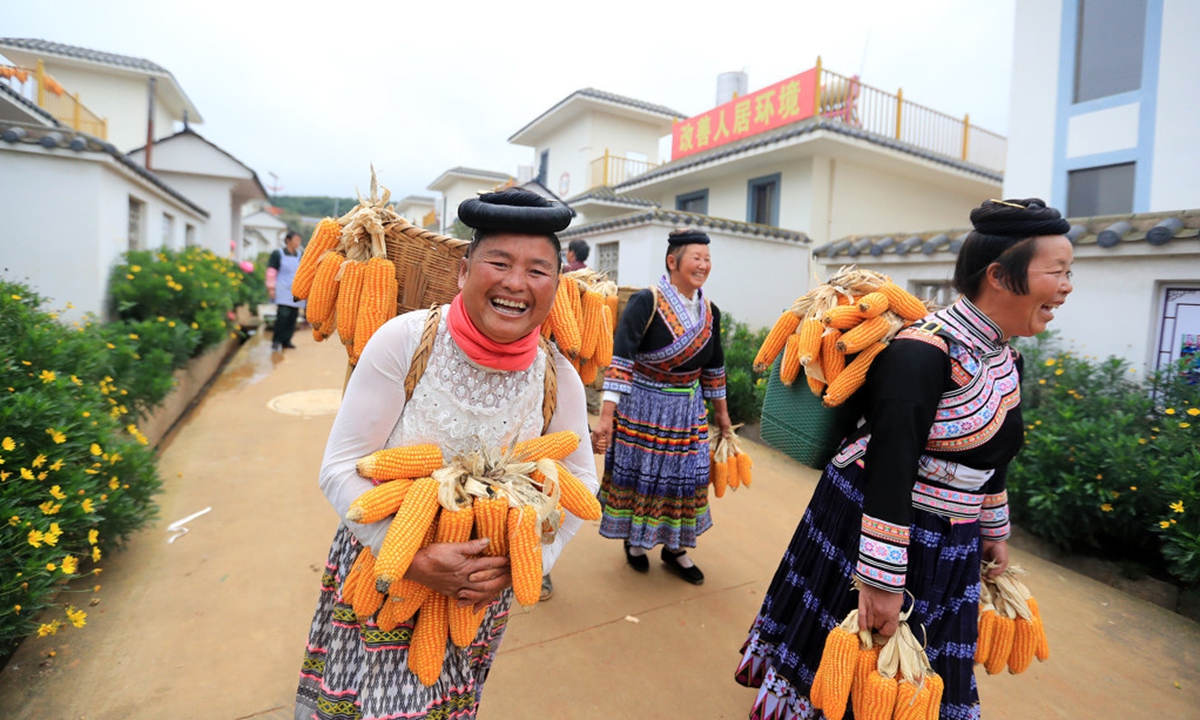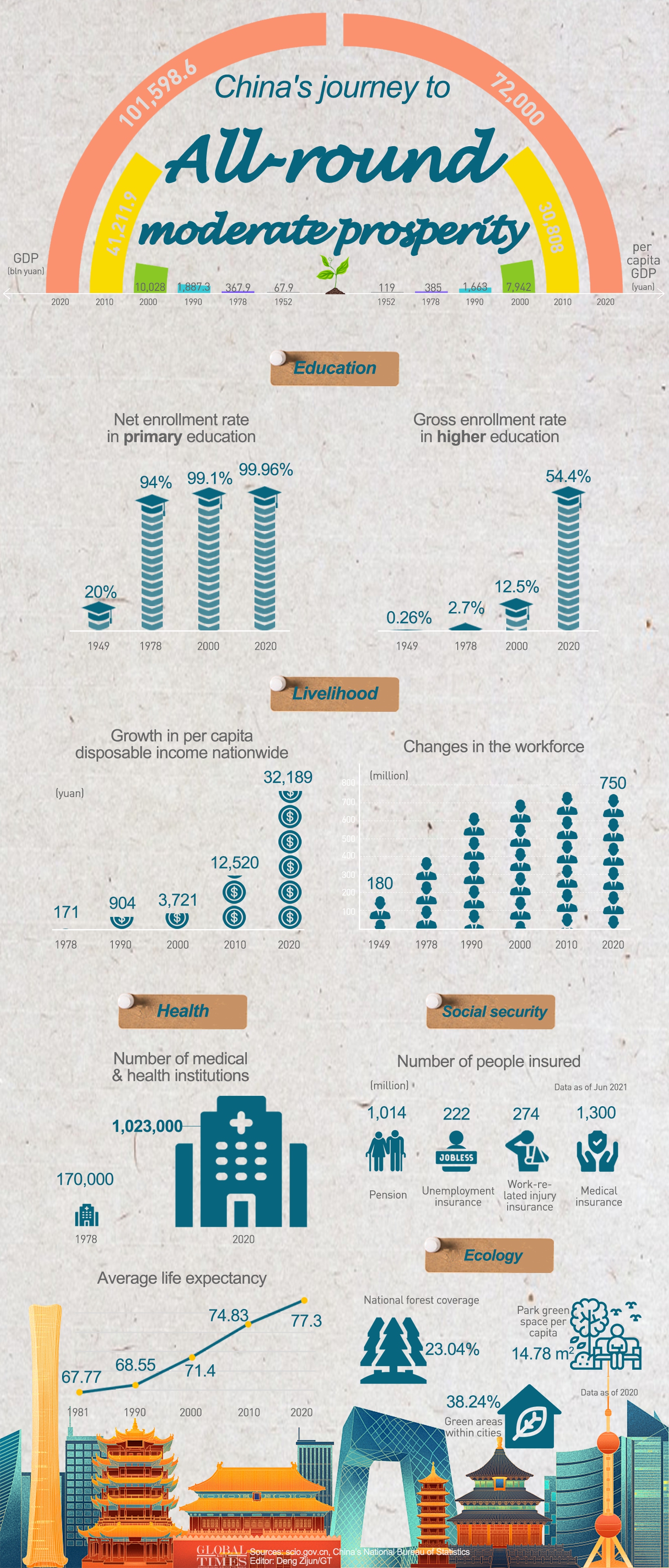China's success in achieving moderate prosperity opens new path to modernization for humanity: white paper

Aerial photo taken on July 24, 2021 shows a view of a relocation site for poverty alleviation at Huawu Village in Xinren Miao Township, Qianxi City, Southwest China's Guizhou Province. Photo: Xinhua
China's success in achieving moderate prosperity (xiaokang) not only injected great energy in China's national rejuvenation, contributing to world's peace and development, but also highlighted the basic requirements of common prosperity, said a white paper issued on Tuesday.Common prosperity requires the solid foundation of xiaokang, analysts said, noting that achieving xiaokang reflected how China's system mobilizes nationwide resources to achieve great goals; and that such strength can give China better play to meet future challenges in a world of great uncertainty.
The 32,000-word white paper, entitled "China's Epic Journey from Poverty to Prosperity" and issued by the Information Office of State Council, noted that the country's experience offers a new option for countries and peoples looking for growth and independence, and its success provides them with considerable opportunities for development.
China's modernization - featuring common prosperity, balanced material and cultural progress, harmonious coexistence between humans and nature, and peaceful development - will be shared by a huge population, it said.
The white paper also highlighted the big strides China made on various walks of lives, including helping 770 million people in rural areas shake off absolute poverty, successfully building the world's biggest social security system, and making nearly 20 percent of the world's population embark on a new road of building a modern socialist China.
In the future, China will continue to embrace and interact with the rest of the world, adopt a more open and inclusive mind-set, and contribute even more to building a global community of shared future and a better world, said the white paper.
Chinese President Xi Jinping, also general secretary of the Communist Party of China (CPC) Central Committee, announced on July 1, the centennial of the founding of CPC, that China had realized its first centenary goal - building a moderately prosperous society in all respects. Then in mid-August, Xi stressed efforts to promote common prosperity in the pursuit of high-quality development and coordinate work on forestalling major financial risks.

Villagers attend a wedding ceremony held in Xiaohaixin village, their new living community after poverty alleviation relocation, Xundian county, Southwest China's Yunnan. Photo: IC
From xiaokang to common prosperity
To achieve common prosperity on the solid foundation of xiaokang, analysts said that promoting rural revitalization, narrowing the income gap by improving the distribution system and balancing regional development are core challenges.
China is confident that it has the capability and resources to realize the second centenary goal - to become a modern socialist country that is prosperous, strong, democratic, culturally advanced, harmonious, and beautiful by the middle of the 21st century, according to the white paper.
China has set targets through 2035 to achieve socialist modernization, of which the per capita GDP will reach the level of moderately developed countries - at least $20,000, according to the standard of the World Bank.
The difficulties to reach such target lie in less developed regions in China - the central and western regions that have more rural areas. Therefore, rural revitalization is a very important and indispensable component of China's common prosperity, Tian Yun, former vice director of the Beijing Economic Operation Association, told the Global Times on Tuesday.
Tian noted that first of all, more jobs should be created, especially in urban areas, so that migrant workers can stay. To create more jobs, modernization should be accelerated, which includes industrialization that creates supply, and urbanization that creates demand.
Sun Wenhua, director of the China Agriculture Industry Chamber of Commerce at All-China Federation of Industry and Commerce, told the Global Times on Tuesday that the formation of a new type of relation between industry and agriculture, urban and rural areas has been accelerated in China. Transportation has accelerated the two-way flow of goods and people between urban and rural areas, which boosted modernization in rural areas.
"Rural revitalization needs to focus on the development of regional economy, that is to create unique industries like rural tourism and compound agriculture," Sun remarked.

Xinjiang Photo: VCG
Stark contrast
"To narrow the wealth gap and tackle imbalanced development, China has a strong central government, which has the power of mobilization, and all levels of local governments are empowered by the staunch ability of implementation, and those are what makes China to mobilize the whole country to achieve its goals, to make great progress," Bai Wenxi, chief economist of Interpublic Group of Companies (China), a global provider of marketing solutions, told the Global Times on Tuesday.
Tian gave more detailed examples such as sending experts to rural areas to provide them technological support in production; and issuing the preferential policies to less developed areas. "Those policies won't have visible economic benefits in short term," Tian noted, explaining yet they are necessary and can only be realized under the CPC's leadership.
Echoing those experts, many netizens hailed China's unique system in achieving moderate prosperity. Some compared the Chinese government's efficient moves in pulling people out of poverty to the US struggling to narrow its widening and staggering wealth inequality.
The US and China are being locked in competition, ranging from technology to human rights, which observers said in essence is the US trying to thwart China's rapid development. "But in the future, such competition relies largely on who could better solve its countries' problems, and who can better handle he relationship between government and society," Yang Xuedong, a professor of political science at Tsinghua University, told the Global Times on Tuesday.
Analysts also said that the competition between China and the US depends on who can first resolve the income gap at home and first become the largest low-carbon consumer market.
Yang pointed out that China has an edge on its system and are empowered by traditional advantages, making it stronger, and the US is better at giving play to a certain individual. "The key is how to wield its advantages under this new circumstance," said Yang.
Even since the COVID-19 pandemic, the US has been deeply mired in its racial and wealth gap, and is also still ravaged by the deadly disease and sluggish economic growth. Yet China, which bounced back fastest from the pandemic, has successfully helped 98.99 million people in rural areas living below the current poverty threshold shake off absolute poverty; and its economy is recovering the fastest worldwide.

China's journey to all-round moderate prosperity. Infographic:Deng Zijun/GT
